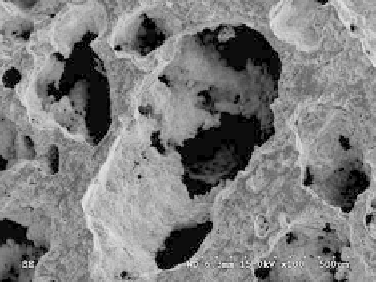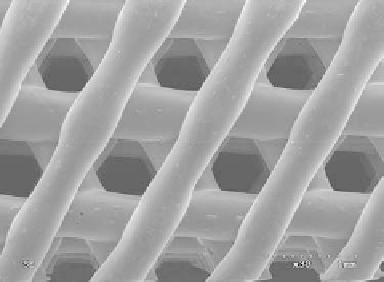Biomedical Engineering Reference
In-Depth Information
(a)
(b)
FIGURE 21.15
(a) Porous titanium scaffold made by powder sintering and (b) polymeric scaffold made
using fusion deposition modeling (FDM) by group of D. Hutmacher (National University of Singapore).
phenotypes. This is due to profi table mechanical proprieties, durability, elasticity, and the control-
led surface hydrophobicity of polyurethane scaffolds. In addition, the biodegradable polyurethanes
show a relatively low
in vitro
degradation rate, which follows a low rate of changes within the
chondral tissue [58]. Current research shows that 3D scaffolds prepared from linear, biodegradable
polyurethanes can be used as chondrocytes carrier [59]; however, this is not an ideal scaffold.
In the majority of the TE approaches, the above-mentioned materials were used to produce 3D
highly porous scaffolds for the cells. The high porosity is obtained by several methods, such as
freezing-thawing, salt or ice leaching, casting, foaming, sintering (Figure 21.15a), solid freeform
fabrication or rapid prototyping (Figure 21.15b), and fi ber bonding.
When the cartilage defect is accompanied by subchondral bone, the regeneration of the so-called
osteochondral defect requires the usage of a hybrid or biphasic scaffold, which has a specifi cally
designed cartilage compartment and a bone compartment [60]. Swieszkowski et al. [61] analyzed
two types of hybrid scaffolds: (i) the i rst biphasic scaffold consisting of i brin (cartilage phase) and
poly(ε-caprolactone) (PCL) (bone phase); (ii) the second type of scaffold using PCL as a cartilage
phase and PCL-TCP as a bone phase. The fusion deposition modeling (FDM) was used for scaffolds
fabrication (Figure 21.15b). The results of
in vivo
animal studies demonstrated that the porous PCL and
PCL-TCP scaffolds promoted bone healing. Integration of a regenerated cartilage with native one was
problematic. A better cartilage regeneration was obtained when the PCL scaffold has been used.
Application of PLGA microspheres in TE was also reported [62]. The characteristics of cartilage-
like tissue as a result of PLGA microspheres-chondrocyte arrangement showed to be very similar
in vitro
to properties of natural tissue, and they can fi nd applications in TE [62].
21.5 TOTAL JOINT REPLACEMENT
When AC is severely damaged because of a trauma or diseases such as osteoarthritis or rheumatoid
arthritis, the total joint replacement (TJR) is the most widely used treatment method.
TJRs are designed to mimic the anatomical joint structure and function as much as possi-
ble using available engineering techniques and materials. The affected and painful joint surfaces
are removed and replaced by two components, which restore the concave and convex geometry of
articulating surface of natural joint. The concave component material consists mainly of the ultra
high-molecular weight polyethylene (UHMWPE).
UHMWPE was classifi ed as a form of high-density polyethylene (HDPE) in the early 1960s [63].
It has been fabricated using the Ziegler process [64]. UHMWPE has a molecular weight ranging
between 3.1 and 5.67 g/mol million. For comparison, the molecular weight of HDPE is lower than



